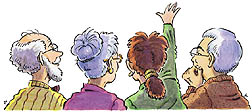 They're auditors.
They're auditors.Princeton on $5/day
Auditors get the best of Princeton faculty and classes-cheap
Walk into almost any Princeton lecture hall and you'll see them, quiet, attentive, often gray-haired, seated in the back rows per instructions. They're passionate about learning, and they're getting a Princeton education for a pittance.
 They're auditors.
They're auditors.
Lew Hirsh, Art Fenigstein, Mel Newman, and Jules Hyman drive from Bucks County, Pennsylvania, twice a week to attend Peter Schaefer's class, Jewish Mysticism from the Beginnings to Kabbala.
Pete Weiland '55 of Princeton is taking The Civil War and Reconstruction, taught by Pulitzer Prize winner J. M. McPherson, George Henry Davis '86 professor of American history.
Bob Varrin '56, an engineering graduate who said he should have majored in history, is making up for it now. He took Imperial Russian history last semester; this semester he's in the Civil War class and William Jordan's course on the High Middle Ages.
Ellis and Ruth Winikoff, who moved from Minneapolis to a retirement community near Cranbury, are auditing Russian Literature and Art 101, the survey course in art history, this semester. They've been auditing for years and love it, gobbling up courses in history, religion, literature, political science. "It's a privilege," they say. "Everything we've taken has been fabulous. Our kids can't believe we're going to Princeton."
They are just a few of the approximately 400 auditors at the university this year. Princeton has always allowed auditors to sit in on lecture courses, and for decades undergraduates have been used to the stray "adults" from the community sitting in on classes. But recently, as the area has become more of a magnet for retirees, the number of auditors has increased exponentially. Faculty and administrators began to complain of an increased workload as would-be auditors called constantly to find out where and when classes met. Increasing numbers of people were spotted wandering freely around campus, looking in on classrooms. And in some popular courses, there were so many auditors that enrolled students couldn't find seats.
"It was impossible to control," says one administrator.
So last fall the university launched the Community Auditing Program, with Pam Hersh, director of the Office of Community and State Affairs, in charge. "This is simply a registration process for individuals who would like to audit university lectures," Hersh says. "We needed a cohesive program with positive community benefits" that did not place a burden on university personnel. There was also some concern about the university's liability for hundreds of unauthorized persons on campus. Registration would put auditors under the university's insurance coverage and give the administration a way to check abuses and protect the interests of matriculating undergraduates.
Now all auditors must register with the Community Auditing Program, pay a fee of $50 per course, and receive a registration card. If a would-be auditor cannot afford the $50 fee, it's waived. This semester, at least two auditors have received this "financial aid."
Even when the fees are waived, auditors must register during the formal registration period set up for them each semester. They must choose from a list of selected lecture courses, approved by the professors and department managers, and may not attend labs, seminars, or precepts. If their first-choice class has too many auditors, they may choose another.
Last fall 470 auditors registered; this spring there are 360. (Many retirees go to Florida in the winter, Hersh explains.) None of the auditors seems upset by the fees or the registration process. In fact, some realized themselves that the situation was out of hand and feared that unless it was regulated, the university might cut auditing out altogether.
"It's a win-win situation now," said Marietta Taylor, head of the Community Auditing Council which Hersh organized to get community input. "The auditors like it. The professors like it. The university likes it."
Taylor, wife of Dean of the Faculty Joseph Taylor, has audited courses ever since she retired from her own job at the university.
Although auditors pop up in a wide variety of courses, art history is their favorite field-38 are in Art 101, the survey course, and 15 in Art 212, Neoclassicism through Impressionism. Music, literature, and history follow close behind.
Like many auditors, Naomi and Jerry Rose choose courses according to who's teaching them, zeroing in on big names like McPherson, Anthony Grafton, Dodge professor of history (they loved his two-semester course on western civilization, which they refer to as "Plato to NATO"), and Elaine Showalter, Avalon Foundation professor of the humanities.
In fact, auditors share bootleg copies of "faculty not to be missed," a list compiled by Enoch Durbin, professor of mechanical and aerospace engineering.
"Princeton is jammed with super faculty members who are superb teachers," says Durbin. "When I'm advising students in engineering, I always urge them to take classes from the great professors, professors who are so enthusiastic about their subject that they can't see why everybody in the world isn't studying Slavic literature, for instance."
Durbin's list includes Uwe Reinhardt, James Madison professor of political economy; Ellen Chances in Slavic literature; Sean Wilentz, Dayton-Stockton professor of history; John Wilmerding, Christopher Binyon Sarofim '86 professor in American art; Edward Champlin, Cotsen professor of classics; and a score of others. "I tell the students these teachers will change their lives," says Durbin.
Faculty attitudes toward auditors range from Durbin's enthusiasm through tolerance to occasional annoyance. Sara Curran, assistant professor of sociology, is especially glad to have auditors in her sociology course, Sex, Sexuality, and Gender.
"I always have at least two or three auditors [this semester she has seven], and I like having them," she says. "They offer a perspective on life that most students haven't even imagined. In the first half of the course, we talk about youth and adolescence and the undergraduates know about that. In the second half, when we talk about marriage, the family, and work, they don't know about that. But the auditors do. I encourage the auditors to talk. They are very respectful and wait for the students to talk first, but when I keep pushing, they say something that's quite helpful. The class would be quite different if they weren't there."
English professor Claudia Johnson, who teaches a popular course on Jane Austen, likes auditors too. "It broadens the age group of the classroom, which at Princeton tends to be quite narrow, and I think this is good for young students to see, even if the auditors are just there listening." She adds that auditors demonstrate that education is ongoing, and remind students that "pleasure, too, is a legitimate object of learning-that taking a course on Jane Austen can simply be fun as well as count toward some requirement."
Not all professors are as upbeat. "Some auditors are cranks," says one. Another faculty member complains that auditors sometimes ask off-the-subject questions or become argumentative.
Even other auditors recognize occasional problems. "Auditing is wonderful, but auditors should be careful to sit in the back of the room," said auditor Mark Rutzky. "Some of the elderly ones can't see and can't hear and they like to sit up front, but they should let the students get first crack."
Some auditors are frustrated by their limited role. Pete Weiland does all the reading for his Civil War course, and wishes he could go to the precepts. "I'd like to know at least the questions the professors ask in precepts, so I'd know what the professors think is important," he said.
But despite a few bumps, most auditors are happy with the program. Bob Varrin is one of them. "I don't mind not going to precepts, and I don't do the reading," he says. "It's still the greatest thing on earth."
Ann Waldron is a freelance writer living in Princeton.
A (very) brief history of PAW
On the occasion of its 100th anniversary
By J. I. Merritt '66
With this issue-its 3,001st-the Princeton Alumni Weekly is 100 years old.
Paw's first issue, dated Saturday, April 7, 1900, offered 16 pages of campus and alumni news and editorialized for greater alumni involvement in Princeton. Editor Jesse Lynch Williams 1892 bemoaned "the meagre dissemination of authentic information" about the university to its 6,000 sons and the fact alumni weren't even guaranteed representation on the Board of Trustees. "To a casual, disinterested observer," he wrote, ". . . it must seem very remarkable, not to say pathetic, that Princeton men, who are so blatantly fond and full of their college, have nothing officially to say about the running of it."
From the beginning, then, paw struck a note of feisty, even contrarian, independence. The magazine was founded by alumni for alumni as a means of keeping in touch with the university and with each other-a kind of "long distance telephone," as Williams put it, "for their mutual enlightenment, benefit and satisfaction." The premier issue carried a letter from John D. Davis 1872, the chief mover among the magazine's founders and the president of the Princeton Club of St. Louis. Davis complained about the trustees' foot-dragging on a promise to create an alumni council and their failure to act on a suggestion (put forward by the Princeton Club of New York) to permit alumni to elect trustees.
Volume I, Number 1 also featured several pages of class notes and two obituaries (for 94-year-old retired physician Samuel Hayes Pennington 1825, the oldest living alumnus, and corporate lawyer William M. Addicks 1874). Readers could sample reports on the last trustee meeting, prospects for the baseball team, campus religious meetings (at one, Professor Woodrow Wilson 1879 spoke on "Why a College Man Should Be a Christian"), and alumni dinners in Newark and Chicago. At the Newark gathering a speaker denounced undergraduates who ridicule other students who "devote themselves assiduously to study," and President Francis Patton used both occasions to push for the establishment of a law school.
Davis was one of a group of prominent alumni-others included Charles Scribner 1875, Moses Taylor Pyne 1877, and Cornelius C. Cuyler 1879-who raised $10,000 to launch paw. Five years later, the parent firm they founded, the Princeton Publishing Company, morphed into Princeton University Press, which published paw until 1991, when governance passed to Princeton Alumni Publications, Inc., a nonprofit corporation.
Davis's son, J. Lionberger Davis 1900, was the last editor of The Alumni Princetonian, a spinoff of The Daily Princetonian and a kind of proto-paw which had published weekly during the school year since 1894. Most of its articles were lifted from the Prince and repackaged for an alumni audience, but the fare also included letters, obituaries, and rudimentary alumni notes. The Alumni Princetonian's finances were probably never robust-it had no advertising and only 500 subscribers, a 12th of the university's graduates-and there was growing sentiment among alumni that they ought to be in charge of any publication intended for them. Davis père founded paw at his son's urging, and the magazine's debut was announced in its predecessor's last issue, dated February 22, 1900.
From these modest beginnings paw grew and flourished, aided by the inspired editorship of Williams (who, after leaving the magazine in 1904, went on to win the 1918 Pulitzer Prize in playwriting) and his successor, Edwin M. "Teddy" Norris 1895, whose 21-year tenure (1904-25) was the longest in the magazine's history (he was also the only editor to die in the job). In 1914, Norris enlisted Christian Gauss, one of Woodrow Wilson's original "preceptor guys" and mentor to the likes of Edmund Wilson '16 and F. Scott Fitzgerald '17, to write a regular column on books, and he hired senior Weir Stewart '15 as the first columnist for a department called The Undergraduate Week. In the 1920s the name changed to On the Campus.
Paw's early success owed much, too, to the capable Whitney Darrow 1903, its first business manager. In 1915 Darrow devised a system by which alumni classes purchased subscriptions for all their members, and his "universal subscription plan" has been the foundation of the magazine's finances ever since. That year, the magazine also established the Board of Editorial Direction, a governing body of alumni in the field of editing and journalism; a separate advisory group, charged with overseeing the magazine's finances, came into being in 1971.
Paw has evolved over the years in both form and content. The first issue was entirely text, with not a single image. The first halftone, a photo of the graduating class, appeared in the issue of June 9, 1900. Paw was probably the first alumni magazine to establish a presence on the Internet, way back in 1984, when editor Charles L. "Chuck" Creesy '65 (1974-87) went online with "Electronic paw," a kind of chat room that posted articles and news and even offered an "electronic precept," hosted by Professor of Sociology James Beniger, on the social impact of computers.
By and large, the magazine has more than lived up to its purpose, as stated on the masthead since the 1920s, "to review without partiality the achievements and problems of the administration, the faculty, and the student body of Princeton University." To the extent that paw is a reflection of campus life and alumni attitudes, one finds over the years certain striking consistencies. One is the deeply rooted tendency for graduates to chide the behavior of students: Quoting President Harold Dodds *14, editor John D. Davies '41 (1955-69) noted that "flogging the younger generation has always been good therapy for the old." In recent decades the Letters department has crackled with outrage at the Nude Olympics and the bawdy innuendo and tasteless jokes of the Marching Band's performances at football halftimes. But as long ago as 1900, readers were voicing indignation over touring glee-club members who got obstreperously drunk at alumni-sponsored receptions (editor Williams concurred that "a good spanking" would take care of the problem).
An issue that refuses to go away-Dodds called it a "hardy perennial"-is concern over the eating clubs' domination of undergraduate social life. In the issue of October 13, 1900, editor Williams concluded that the "trouble lies not in the clubs themselves but in the filling of them" (i.e., bicker, a term that didn't come into general use for another decade), then presciently added, "Whether for good or bad, these clubs are here to stay."
The preeminent clubman Scott Fitzgerald wrote one piece for paw, on "How to Succeed in the Advertising Business," and has what may be the unique distinction of dying while reading the magazine. A heart attack felled the novelist as he was marking up a football article in the December 9, 1940, issue. His copy is now in the Fitzgerald archives in Firestone Library.
For its first four decades paw published an issue every week of the academic calendar-36 per year. Its frequency dropped to 32 during World War II. A slow but inexorable decline continued. The magazine was producing 27 issues a year by 1977, when it went biweekly-while retaining its by now quirkily anachronistic title-and frequency dropped to 21. Largely for budgetary reasons, frequency slid further before stabilizing in 1988 at the current 17 issues per year. By a healthy margin, however, it remains the most frequently published alumni magazine (the runner-up, Ohio State's, appears 10 times a year).
For a century, paw has indeed been what first editor Williams envisioned: "a common meeting ground," for university and alumni.
Jim Merritt edited paw from 1989 to 1999. He is currently at work on The Best of paw, an anthology celebrating paw's centennial.
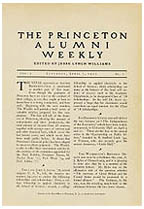 April 7, 1900
April 7, 1900
The first cover of the first issue of paw was all text. Editor Jesse Lynch Williams 1892 wrote an early 20th-century version of an editor's note that introduced a story on "the vital question of alumni representation" as well as an upcoming series of reports on the current state of the university. On page 6, he wrote, "It is unnecessary to explain the duties of a news-sheet addressed to the alumni of a university."
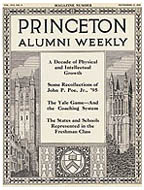 November 17, 1915
November 17, 1915
By its second decade-now under the direction of Teddy Norris 1895-paw used its cover as a table of contents, always surrounded by engravings of Princeton icons: the tower of Holder Hall, Cleveland Tower, and the University seal. Yes, Yale won that year, 13-7-leading to the article on the coaching system.
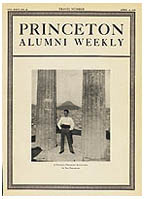 April 14, 1926
April 14, 1926
The icons had faded away by the time of this cover, which featured renowned adventurer and author Richard Halliburton '21. Halliburton's story was titled, "How to Swim the Hellespont on a Can of Sardines," and detailed the fulfillment of his long-cherished dream to swim the "most romantic river in the world-the Hellespont."
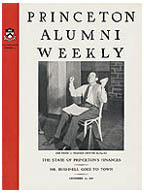 December 10, 1937
December 10, 1937
This short-lived design featured an orange banner running down the left side. Broadway star José Ferrer '33 graced the front of this issue; inside, the caption read: "Mr. Ferrer, who is directing the Triangle show in a more philosophical spirit than the libellous picture on this week's cover would suggest, played the title role in the Triangle Club's 'It's the Valet,' and since then has appeared on Broadway in 'Spring Dance,' 'Brother Rat,' and other plays."
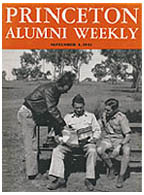 September 4, 1942
September 4, 1942
Even World War II couldn't keep alumni away from paw. The picture was described inside: "The Weekly follows the flag. The photograph on the cover was taken in Australia. Forwarded to 1935 class secretary D. C. Stuart Jr. and loaned by him to the Weekly, it depicts John S. Scully III '35 with T. S. Capers Jr. '37 and William F. Logan Jr. '35 reading the March 20th issue."
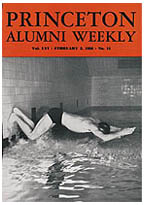 February 3, 1956
February 3, 1956
Cover note from editor John D. Davies '41: "Our personal nomination for the most dedicated athletes at Princeton are the swimmers, who week after week, month after month traverse the same monotonous course with the same stroke up and down the lonely waters of University Pool. . . . As faceless automatons they just splash along face down. Maybe this guy isn't face down. Try him other side up."
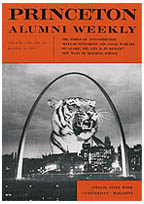 March 16, 1965
March 16, 1965
Davies, still the editor nine years later, explained away this cover by saying, "In a fit of absent-mindedness paw promised this cover to the Princeton Club of St. Louis as a sort of billboard to advertise the forthcoming 'Meet me in St. Louis' National Alumni Conference. Here is what they came up with-advertising indeed!" Inside was a picture of the same cover-with a small, tiger-striped ocelot inside the arch.
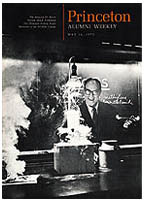 May 16, 1972
May 16, 1972
This cover celebrated the 42-year teaching career of chemistry professor Hubert Alyea, who was well known for his spectacular "pyrotecnic [sic]" lecture "Lucky Accidents, Great Discoveries, and the Prepared Mind," with which he annually entertained alumni at Reunions. Editor Landon Y. Jones '66 encouraged readers to catch Alyea's farewell performance.
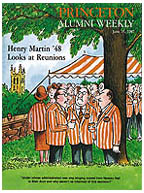 June 10, 1987
June 10, 1987
No look at paw would be complete without an illustration by cartoonist Henry Martin '48. Martin's lovable old coots, Tigers, spires, and arches have appeared many times in these pages. In this issue, he sent up Reunions in classic Martin style-such as the one in which a Reunion-garbed man standing in a classroom says to another, "I didn't understand that lecture in 1965 and I didn't understand it today."
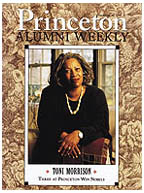 November 10, 1993
November 10, 1993
Coming full circle: Original paw editor Jesse Lynch Williams won the
Pulitzer Prize for playwriting in 1918. Seventy-five years later, Pulitzer
Prize-winning author and Robert F. Goheen Professor in the Humanities Toni
Morrison won the Nobel Prize for literature, and was featured on paw's cover.
Jobs, weddings, babies, and golf games: Class Notes records the pace of alumni lives
by Lolly O'Brien
A former editor of paw often said, and correctly, that the heart of this magazine is Class Notes. In our reader surveys, almost 100 percent of responders say they read Class Notes, theirs and the columns immediately surrounding their own.
News in class columns is rarely sensationally gripping-in fact, over time, the repetition of basic biographical data can become mind-numbing: graduate schools attended, professional positions attained, marriages made, children born, lectures delivered, books published, awards received, retirements completed, golf triumphs recounted, and grandchildren enjoyed. (Then, of course, the inevitable: the deaths, the reports of which, in contrast, never seem to dull the mind. When a reader follows the course of someone's life, even in print, the loss is felt.)
With approximately 62,000 graduates since 1900, that's a lot of jobs, marriages, children, and grandchildren.
During the first years of paw, Class Notes was called Class News, and the items were usually short-often one item made up an entire class's column. Some columns did report on two or three classmates of the class, but within a few years, no secretary published a column with only one son of Nassau mentioned.
During the early part of the 20th century, Class News was larded with reports of alumni being placed as ministers in the Presbyterian Church. In the December 21, 1901, issue, the Class of 1896 reported: "Besides the largest class ever graduated, '96 has a greater proportion of its members in the ministry than any recent class. Of its 225 members who received their bachelor's degree, 36, or 16 per cent., studied theology, most of whom are now actively engaged in ministerial work in various parts of the world."
Nowadays, Class Notes is fat with announcements about alumni finding positions with Internet companies.
Back in the old days, when the classes were much smaller-the Class of 1900 had 186 members-most anything made Class News: In May 3, 1916, the Class of 1909 reported, "Robert F. Rockwell, who attended the class dinner in February, is home again in Colorado." Not to belittle that accomplishment, but few secretaries today could publish such mundane news, especially given that current classes have well over 1,000 members.
Naturally, a reflective reading of Class News in the early part of the century offers a glimpse of another era: In May 31, 1902, the Class of 1876 reported, "W. J. Henderson, the art critic of the New York Times, is to contribute to the July Atlantic an article on Sailing." Doesn't that sound genteel?
Or a glimpse into the future: In September 28, 1956, the secretary of the Class of 1956 reported, "John Doyle, working out of IBM's New York office, is selling electric typewriters in the Bowery. He swears there's a market for same . . . "
In the pages of back issues, another kind of history comes forward. Old Princeton names reappear, as succeeding generations of bright eyes make their way to campus and get reported on over their lifetime, names such as the Garretts, the McAlpins, the Erdmans, the Medinas, the Van Dusens.
Charming accounts have often graced paw's pages, and sometimes non-Princeton news is printed, then savored by a class fond of its secretary and willing to put up with his word wizardry. In the January 13, 1926, issue, the secretary for the Class of 1898 wrote, "Once again we brazenly announce our name as appearing in the public print, and this time it blossoms forth on page 143 of the new New York City telephone book. So many classmates passing through the city claim they would have called us up only they never can remember our telephone number and so, braving process and subpoena servers, we come out into the open for the public weal and will be much disappointed if frequent telephone calls and free lunches do not follow."
He goes on to add, "This morning, while looking through the paper, we were startled to see that John R. Booth, 98, father of a princess, died, and we began to wonder who Booth, 98, was. Upon reading through the article we discovered, however, that Booth was a Canadian lumberman and that the numerals referred to his age and not his Class. A true story."
Space for Class Notes in the current paw is at a premium. Secretaries routinely clamor for more and would never include extraneous news of a non-Tiger. The 300-word limit now in place is fine for, say, a class from the 1920s, but it barely covers the Class of 1999, with 1,186 members, all of whom we're sure will go on to myriad jobs, marriages, babies, golf outings, and grandchildren.
Going into the next century, when the nature of class news reporting is bound to undergo a profound shift to e-mail and Web sites, you can be sure that the content won't change, only the medium.
Institutional Memory
A short-lived newspaper-and its editor-had a lasting effect
by Samuel A. Schreiner, Jr. '42
I arrived at Princeton from a public high school just a few months after my 17th birthday. At 120 pounds and virtually blind without my glasses I was not a candidate for any athletic team. I was so overwhelmed by the demands of college-level courses that I lacked the time and confidence to get involved in any extracurricular activities. By sophomore year, when I began to realize that I had some aptitude for writing, I had already lost out on opportunities to heel for established publications like The Daily Princetonian or The Tiger or even Malcolm Forbes '41's new Sovereign.
Given my situation, I was excited when I heard that a junior named Robert Murray Haig, Jr., was starting a new publication, The Princeton Sunday News.
The concept was sound. Results of major athletic events, almost all of them played on Saturday, constituted the most sought-after campus news. By publishing on the Prince's day of rest, Haig could not only scoop that venerable rag but the outside papers as well. In addition to that advantage, Haig, who had an irreverent sense of humor and a professional level of editorial skill, felt sure that he could create a paper that would be more interesting and exciting than the Prince.
Haig's nickname was "Father." When I found him holding forth in an office underneath the Western Union on Nassau Street, I understood why. He looked a lot older than his years. Separated by a sharp nose, his eyes were sunken into purple- rimmed sockets; his wide mouth was curved into a sad, sardonic smile. I had a feeling that Haig was glad to see any warm body show up, and he wasted no time in putting me to work. With war flickering like heat lightning on the horizon that spring, being pressed into service was the worry of all undergraduates, particularly those in ROTC. "Find out what's in store for them," Haig told me.
Digging up the facts was not difficult; it took only a few phone calls. I sat down and wrote a story that began: "Members of the ROTC unit will not be called into service earlier than their civilian classmates, according to . . . " When I handed it to Haig, he glanced at it, gave me a look of sorrow from those sunken eyes and said, "Can't you do better than that? It reads like something in the Prince."
I snatched the copy back and went for a walk down Nassau Street. I feared that I was about to flunk a last chance to get a foothold in campus publishing. With no experience in writing news copy, I did not have the foggiest notion of what Haig wanted. But desperation bred inspiration. An idea rose from a depth within me which I have since come to hold in awe. I ran back and typed out: "Johnny of the ROTC won't have to get his gun any sooner than his classmates, according to . . . " After he read this version, Haig made a few pencil corrections, spiked it with copy to go to the printer and asked, "Can you cover the crew races Saturday?"
I was an instant newspaperman! Writing the paper was only part of the job. Because of his editorial position, Haig was allowed to have a car on a carless campus-an aging roadster with a rumble seat called Grumph. Every Saturday evening we would take the final copy down to Trenton, have a few beers while the paper was being printed, lug the papers up to Princeton in the rumble seat and hand-deliver them through the dormitories. Sunday dawn became a familiar sight.
Needless to say, I was devastated the following fall when Haig told me that he had folded the paper. Still, it was hard to take umbrage at Haig. His quick mind, dry wit, and disrespect for stuffed shirts and phonies were delightful and infectious.
The last time I saw Father Haig was in the mid-1950s. The features that had given him his nickname on campus had been etched more deeply into his face by his experiences in life; perhaps they were even influenced by early stages of the cancer from which he died much too young. It is loss to us all that we can never know what he might ultimately have accomplished.
Sam Schreiner's latest book was Henry Clay Frick: The Gospel of Greed, (St. Martin's Press, 1996). This article is adapted from a memoir in progress.
GO TO the Table of Contents of the current issue
GO TO
PAW's home page